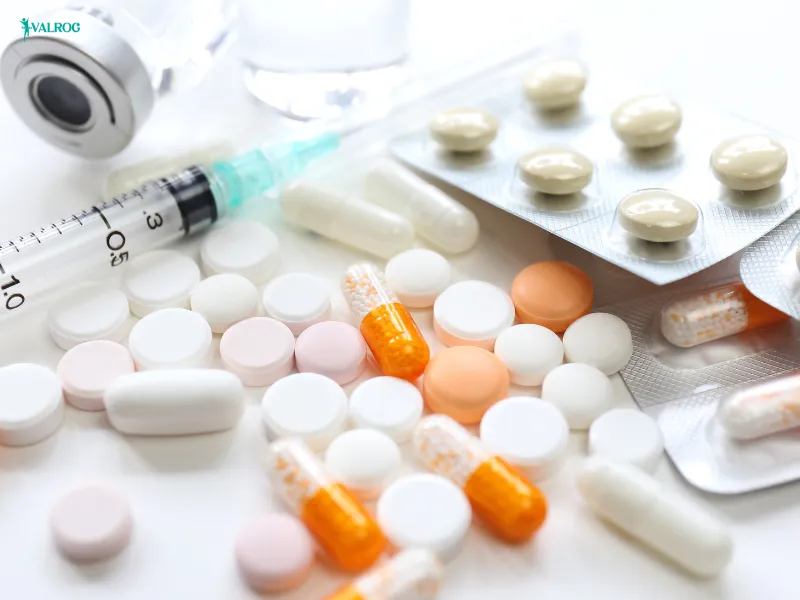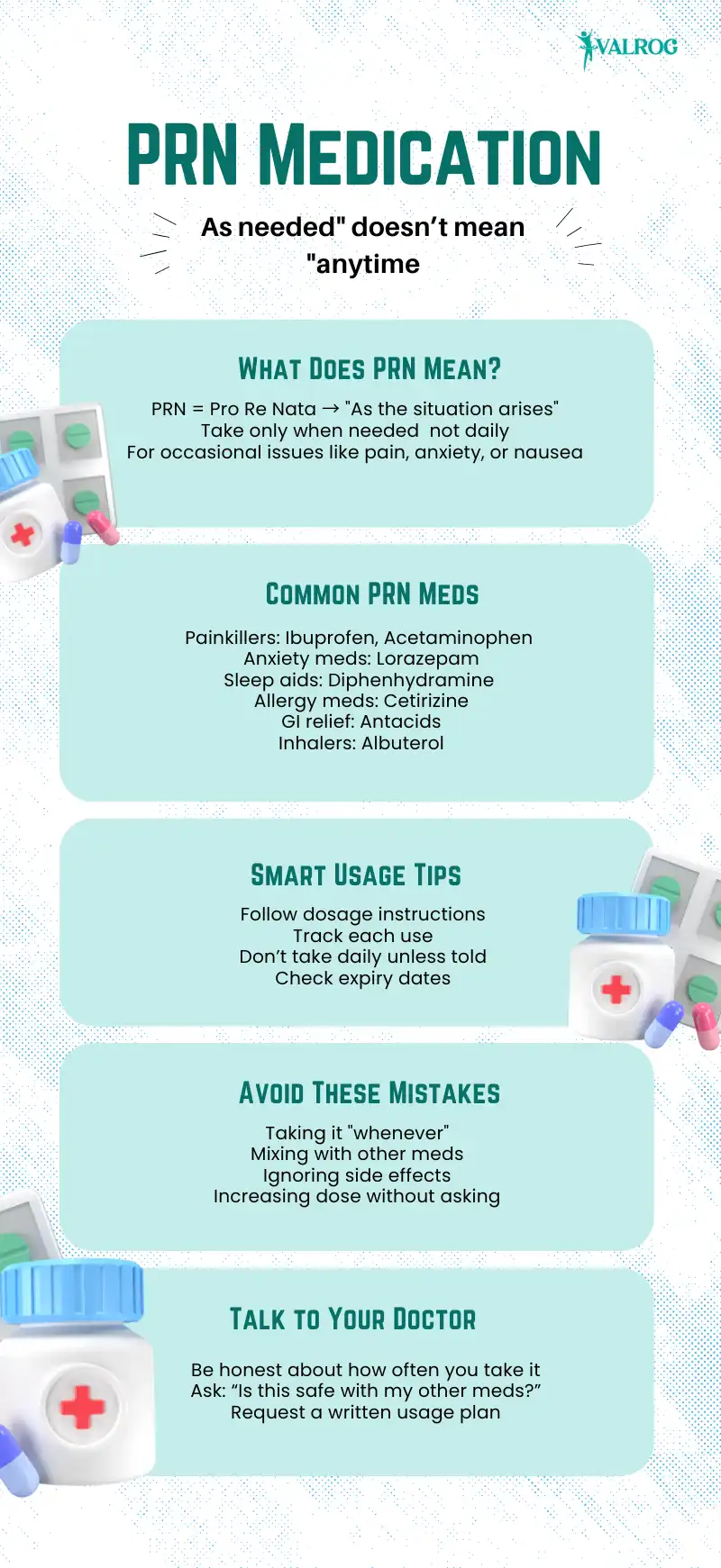“Just because it says ‘as needed’ doesn’t mean whenever.”
Just consider yourself waking up in the middle of the night with a thumping headache. You are aware that you have some medicine with PRN on the bottle. But what is the dosage? And with how much frequency? In case you ever felt ambivalent, you are not the only one.
Your safety and health depend on knowing how to take PRN medications, which are also called as-needed drugs. Anxiety, pain, or allergies, these meds are a safe bet so long as you use them right. However, they may cause overdose, addiction, or diminished results when abused.
So, let us find out more about PRN, the usage of those medicines, as well as the responsible use of those medicines, and how you can remain in control of your health.
What does PRN mean in Medication Terms?
But before we dive into the usage of PRN medications, let us find out what the term PRN means.
What does PRN stand for? PRN is an abbreviation of the Latin term pro re nata, meaning as the situation arises. PRN is a medical term that is interpreted as you can take a medication not on a regular basis, but when necessary.
The PRN pharmacy abbreviation is used to allow doctors, nurses, and pharmacists to specify that the drug is not intended as a routine one. Rather, it is used in only certain symptoms or circumstances.
The concept is practical when the condition being treated is intermittent or episodic, such as migraines, anxiety attacks, nausea, or insomnia.

Visit: The Dos and Don’ts of Treating Diarrhea: What to Know About Pepto Bismol Active Ingredient
Common Types of PRN Medications
PRN medications cover a wide range of drug categories. Understanding which types fall under this label can help you use them more appropriately.
Here’s a breakdown of common PRN drug categories and their real-world uses.
1. Pain Relievers
- Examples: Acetaminophen, Ibuprofen, Naproxen
- Use: Occasional headaches, muscle aches, menstrual cramps
- Risk: Overuse can cause liver or kidney damage
2. Anxiety Medications
- Examples: Lorazepam, Diazepam (used only short-term)
- Use: Panic attacks, situational anxiety (e.g., flying)
- Risk: Dependency and sedation if overused
3. Sleep Aids
- Examples: Diphenhydramine, Zolpidem
- Use: Occasional insomnia
- Risk: Tolerance, daytime drowsiness
4. Allergy Medications
- Examples: Cetirizine, Diphenhydramine
- Use: Sporadic allergic reactions
- Risk: Sedation and interaction with other drugs
5. Gastrointestinal Relief
- Examples: Ondansetron, Antacids
- Use: Nausea, heartburn
- Risk: Masking symptoms of a more serious condition
6. Rescue Inhalers
- Examples: Albuterol
- Use: Sudden asthma symptoms
- Risk: Not a substitute for daily inhalers

Discover: Cough and Headache and Fever: How to Tell If It’s Cold, Flu, or COVID-19
Safe PRN Medication Use
PRN medicines are convenient because of their flexible nature; however, also dangerous in the case of careless use.
Here is a guide to safe practices when utilizing PRN medication.
Follow the Prescription Label Exactly
- Check the instructions: 1 tablet every 4-6 hours as required.
- Pay attention to the maximum dose within a day.
- Do not guess the dose; when in doubt, consult your physician or pharmacist.
Maintenance of Usage Log
Record the date and reason that you took your PRN medication. It prevents the situation of taking a double dose and provides your physician with information about your status.
Don’t Treat PRNs Like Daily Meds
In case you are on a PRN medication and you take it daily, discuss with your healthcare provider. An alternative treatment plan might be required.
Keep Safe and Check Expiry
PRN drugs that are outdated or stored improperly may lose their effectiveness or may become unsafe.

Explore: Emotional and Behavioral Disorders (EBD): Symptoms, Causes and What to Know
Dangers and Misjudgments
Even the chronic patients can misuse the PRN medications. What are the pitfalls? Let us take a look.
Confusion over As Needed PRN
- It does not mean when I feel like it.
- PRN usage ought to adhere to particular symptoms or incidents
Failure to Comprehend Interactions
- Medication PRN can interfere with the daily prescriptions.
- As an example, diphenhydramine interaction with alcohol causes the risk of sedation.
Overlooking Report Usage
Doctors also must be aware of the frequency of PRN medicine intake – it affects your primary treatment course.
Building Tolerance
They can decrease efficiency upon frequent use, particularly the sleeping pills and anti-anxiety medication.
Unassisted Self-Dose
Do not increase or decrease the dose depending on how well it is working. That is something you need to discuss with your doctor.
Learn More: Is Stainless Steel Non Toxic? Full Comparison with Cast Iron
Communication With Healthcare Providers
Effective communication makes you safe. Never hide your PRN drug practice. Here are the suggestions to talk to your doctor or pharmacist about PRN needed medication use.
Be Honest
Be sure to tell your doctor about the PRN meds frequency. No judgment, just better care.
Ask Questions
- “Will this PRN drug interact with my usual drugs?”
- “When is it time to quit using it?”
- “Do safer alternatives exist?”
Ask to Get it in Writing
Ask your provider to write a specific chart or plan on when to take your PRN medication. It is particularly beneficial to older people or caregivers.
When to Stop Taking PRN Medications
Not all PRN medicines are lifelong medicines.
- Your Symptoms Subside
In case the issue has been solved, discontinue the PRN medication. And never keep on “just in case.”
- The Regular Use Becomes the Rule.
Frequent usage can imply that your condition ought to be reassessed. Time to re-evaluate things.
- Side effects get passed on to you
Red flags include drowsiness, nausea, or signs of dependency. Report them on the spot.
How to Use PRN Meds Wisely
- Know what PRN means in medication terms and what the label indicates.
- Understand the reason you’re taking it.
- Track your usage.
- Avoid assumptions. Always consult your doctor.
- Use only as needed—not as a routine.
Using PRN medication responsibly isn’t just about following orders—it’s about knowing when and why you need it. Be proactive, informed, and cautious.
“Medicine sometimes snatches away health, sometimes gives it.” – Ovid
Check this out: Acetaminophen vs Ibuprofen: Which One Should You Choose?
Conclusion
Wise use of PRN medication implies knowing both the flexibility and the limits of this medication. A powerful and fast-acting relief can be provided by these as-needed drugs, but only when taken with precaution, timing, and advice. Always use as directed on the prescription label, keep track of your use, and be in contact with your healthcare provider.
When your use of PRN meds becomes a routine, it can be an indication that it is time to consider a different treatment strategy. It is not only what you take that matters, but how and when you take it to be concerned with your health. Be aware, be alert, and take each dose with a reason. Safety and wellness in the long term are promoted through the responsible use of PRN medications.
